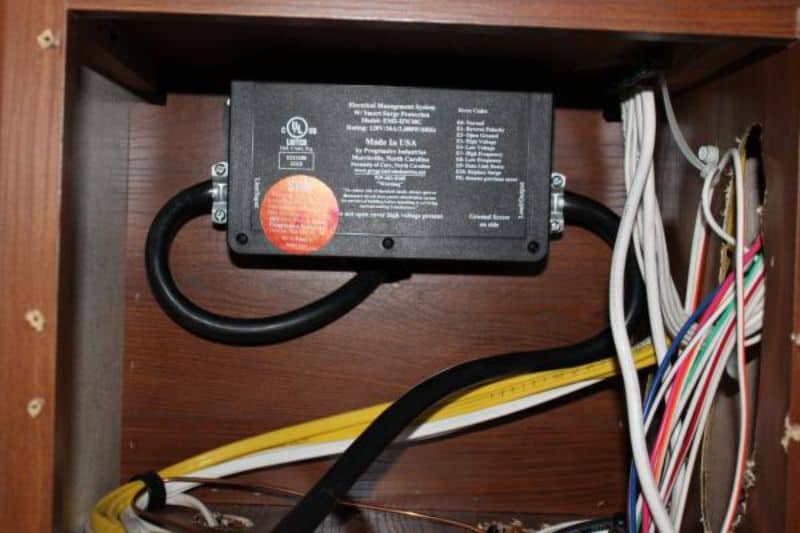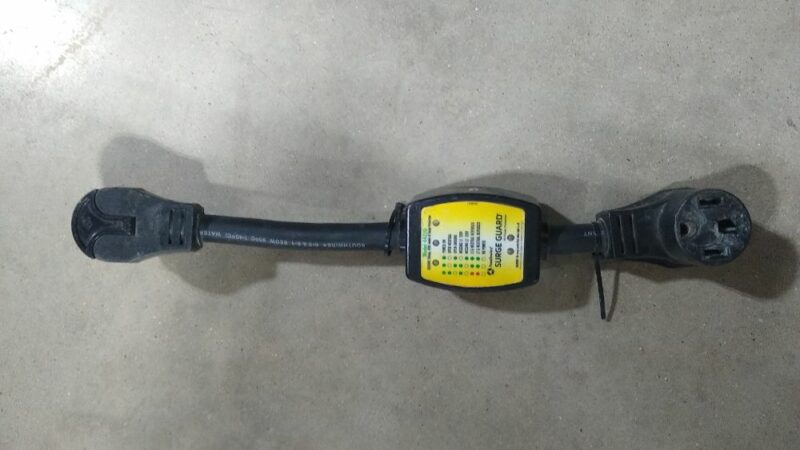If you’ve read my magnum opus about why you need an RV surge protector, you might be wondering whether a hardwired or portable surge protector is better. Are hardwired versions worth the cost? And how often do portable surge protectors really get stolen?
Straightforward answer: A hardwired surge protector is probably the better choice. But if you own multiple RVs, stay at sketchy campgrounds, or don’t know anything about electricity, you should check out a portable surge protector as well.
Quick Introduction to RV Surge Protectors
A surge protector is a sacrificial component that protects your electric system from voltage spikes and surges. It’s like your own private Secret Service detail. It stands guard, silent, sleepless, ready to lay down its life for the good of many. They come in both 30A and 50A versions.
All it takes is one dilapidated campsite, one freak thunderstorm, one power grid brownout, and you’ll be spending thousands of dollars to repair major internal damage to your RV. Consider it cheap insurance.
You should know there are two types of surge protectors: A) basic units that only provide catastrophic protection, and B) advanced “EMS” surge protectors. These are like surge protectors on steroids, and they’re what I highly, HIGHLY recommend.
But since EMS is an acronym and I don’t write like Tom Clancy, I’m using the term “surge protector” as a stand-in in this post. Just know that I’m really talking about advanced EMS surge protectors, and I don’t recommend the basic no-frills units.
But what’s better: Hardwired vs portable RV surge protector?
P.S. I’m also using the term “EMS” as an eponym, like Band-Aid for all “antibacterial flexible adhesive bandages.” Technically only Progressive Industries makes “Electrical Management Systems,” which are advanced surge protectors with diagnostic capabilities, but the term is commonly used to refer to products from its competitors such as Southwire, Camco, and Hughes.
Benefits of a Hardwired RV Surge Protector

You Don’t Have to Worry About the Surge Protector Being Stolen
Portable RV surge protectors have been known to grow legs and walk away. With that said, plenty of people have happily owned their devices for 10 or 15 years. It’s a question of if, not when, something gets stolen. But it does happen.
Most RV surge protectors have a cord bracket or housing eyelet to attach a cable or chain lock. While these won’t defeat a determined thief with an angle grinder or an oxyacetylene torch, most thieves are looking for an easy getaway. Same rules as a zombie apocalypse: You just have to be better protected than the camper next to you.
You Can Trust the Heavy-Duty Design for the Lifetime of Your RV
Think of a hardwired device: Protected inside your RV, anchored firmly to the floor, cossetted by the interior warmth. Now think of a portable surge protector: Naked in the outdoors, beaten by the wind and the rain, banged around every time it’s plugged in. Which do you think will last longer?
You Can Mount the Remote Display Wherever You Want
A quality hardwired RV EMS surge protector will come with a remote display and a data cable. You can install this display anywhere you want inside your RV for easy access. But with a portable unit, you’ll have to trudge out to the device itself – unless you buy a Bluetooth-equipped unit, but that costs significantly more. And you’ll need a smartphone handy to view the data.
You Can Easily Replace Broken Components
Several hardwired units have serviceable components, like circuit control boards. If these components go kaput, you can replace just the single part instead of the entire unit.
It Will Protect Against Faults in the Shore Power Cord
A hardwired surge protector is installed after your power inlet, either before or after your transfer box (if so equipped for a backup generator). That means it protects from any fault upstream, such as a short-circuit in your shore power cord. A portable surge protector is usually plugged directly into the power pedestal, which means it can’t protect against downstream faults.
Contact Pins Don’t Wear Out Like a Portable Device
Loose-fitting contacts will burn out over time. If you often stay at rinky-dink campgrounds, you could damage a portable surge protector with the constant plugging and unplugging – but no such worry with a hardwired unit! (And it’s a lot cheaper to replace a shore power cord than an EMS surge protector).
It’s One Less Piece of Gear
Marines packing for a 6-month deployment pack less gear than the typical RVer embarking for a weekend. If you’re sicked and tired of humping gear from garage to RV and back again, get a hardwired unit. Set it and forget it.
You (Might) Get Easier Warranty Service
Check out these exclusions from the Lifetime Limited Warranty from Progressive Industries:
- Damage to the surge protection unit, such as burnt, charred or melted components resulting from products connected to poorly maintained power sources, power cords or adapters
- Improper use including, but not limited to failure to disconnect upon departure from power source.
- Failure to ensure electrical plugs and receptacles are clean and all connections maintain a snug fit when plugged in.
Burn-out contact pins, dirty receptacles, and forgetting to disconnect when driving away (I’ve done that!) aren’t a problem with hardwired units.
Benefits of a Portable RV Surge Protector

You Can Easily “Install” It!
There’s no installation with a portable surge protector. It’s the definition of “plug n’ play.” If the only thing you know about electricity is it daily resurrects your phone and can turn people into skeletons like in Home Alone, then a portable EMS is for you!
With that said, I should tell you that installing a hardwired RV surge protector isn’t that difficult if you know something about electricity (and know how to work with stubborn 6AWG copper wire). But cross your t’s and dot your i’s, because you’ll void the warranty with improper installation!
You Can Test Multiple Power Pedestals
If you’re staying campground that looks like the maintenance man retired sometime in 1987, you might need to check the power quality at multiple power pedestals. That’s not possible with a hardwired unit unless you happen to have a couple of extra shore power cords (not likely). But with a portable unit, you can easily test the power quality at any source, no matter how far from your parked RV!
You Can Share a Single Surge Protector Between Different RVs
Some people collect RVs like others collect stamps. If you have a truck camper, a restored Airstream, and a Class B conversion van, then do you really need to pay for three hardwired EMS surge protectors?
Well, if you own three RVs, you probably have the money to blow, anyway. But if I’ve misjudged you (and your finances), then you could share a single portable device, like the Greek Fates who all shared an eye.
You Can Keep the Surge Protector for Your Next RV*
I include this as a “benefit,” but I included an asterisk because it’s really not too difficult to uninstall a hardwired unit and pass it down to your next RV. A lot of RVers do this. So you can pass down either a portable or hardwired unit. But if you’re techno-averse, then a portable unit is certainly easier.
P.S. No Generator?
You’ll note I didn’t mention that it’s “easier” to use a generator with a portable EMS. Without getting too deep into the weeds, some generators don’t play nicely with surge protectors, either because they don’t generate pure sine wave electricity, or because they aren’t compatibly grounded. But since most hardwired EMS surge generators have a “bypass” mode just for this purpose, I think neither option takes the win.
Hardwired vs portable RV surge protector? My recommendation: Look to a hardwired unit first. But if you plan on trading in your RV, or you own several rigs, then move to the portable unit.
Leave a Reply